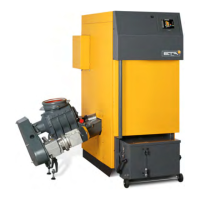
Do you have a question about the eta HACK 20 and is the answer not in the manual?
Introduces the manual, copyright, technical changes, and symbols.
Covers extended warranty, service agreements, and remote control.
Outlines requirements for product function and warranty coverage.
Explains how wood chips are moved and the agitator's role.
Details agitator during filling and discharge screw torque control.
Covers burn-back, ignition, combustion process, and heat exchange efficiency.
Details safety features like underpressure and airtight rotary valve.
Covers trained operation, child safety, fire extinguishers, ash storage, and safety devices.
Details safety valve installation and thermal emergency cooling valve.
Specifies regulations for directing the safety valve outlet pipe.
Emphasizes electrical safety, firebed sensor, and flue gas recirculation.
Explains slag, its causes, and remedies.
Provides settings for fuel, de-ashing, and recirculation based on fuel type.
Provides settings for fuel, de-ashing, and recirculation for larger models.
Details stopping heating, removing excess ash, and inspecting the ash box.
Covers reattaching the ash box and switching the boiler back on.
Introduces the control system, user interface, text menus, help, messages, and inputs/outputs.
Covers system settings like language, date/time, renaming blocks, and time windows.
Details remote control setup and access via meinETA.at.
Provides an overview of the boiler function block and explains key operating elements.
Introduces adjustable parameters and details Fuel and Flue Gas Recirculation settings.
Covers de-ashing intervals, heat exchanger cleaning idle time, and O2 target adjustment.
Displays the buffer tank overview and explains its operating modes.
Guides on setting time windows for buffer charging.
Describes the integration and control of a solar heating system with the buffer.
Explains using the buffer with an integrated hot water tank or coils.
Lists and explains adjustable parameters for buffer settings.
Displays the hot water tank overview and explains its mode of operation.
Guides on setting standby times and temperatures for hot water.
Lists and explains adjustable parameters for the hot water tank.
Shows the module overview and explains its operation for fresh water temperature.
Guides on setting standby times and temperatures for the fresh water module.
Lists and explains adjustable parameters for the fresh water module.
Shows overview screens and explains operation modes for heating circuits.
Details buttons for controlling heating circuit modes and temperature sliders.
Guides on setting heating times and copying them across days.
Explains the heating curve for temperature regulation and how to adjust it.
Explains how to specify heating limits for heating and reduced operation modes.
Lists and explains parameters like Room effect and Switch-on/off diff.
Shows the overview of the solar heating system and its control principle.
Explains the control of a solar heating system with a single tank.
Describes switching between tanks based on priority for solar charging.
Explains switching between internal coils for buffer charging.
Details the control principle for solar heating with an external heat exchanger.
Explains solar heating with an external heat exchanger and stratified charging valve.
Lists and explains adjustable parameters for the solar system.
Shows the auxiliary boiler overview and explains its uses for peak loads or fail-safe.
Guides on setting standby times for the auxiliary boiler burner.
Explains the [Start lag] parameter for delayed operation.
Explains how an external system can demand heat from the ETA system.
Guides on setting standby times and temperatures for external heat consumers.
Lists and explains parameters like Enable temperature and Frost protection.
Explains the heating pipeline as a connection between heat producer and consumer.
Details using the function block to control a heat transfer station.
Introduces silo, double agitator, and intermediate conveyor systems.
Explains intermediate conveyor screws and their overview.
Describes the double agitator system overview.
Sets the time duration for one agitator's operation before switching to the second.
Covers the agitator overview, functionality, and the [Empty] button.
Details pre-filling checks and safety precautions for the fuel store.
Explains the filling process and the requirement for the floor agitator to turn.
Addresses issues with fuel transport, blockages, and the ash screw.
Provides steps for removing the ash screw and clearing blockages.
Discusses fuel types, ash content, preferred wood chips, and waste wood.
Covers decay, mould, storage conditions, and drying of moist fuel.
Explains drying and chopping methods for wood chips.
Details methods for determining and measuring water content in wood chips.
Provides criteria and tables for judging the quality of wood chips.
Offers criteria for judging fuel quality when buying by the kilogram.
Describes the properties and suitability of various fuels like pellets and miscanthus.
Provides tables with heating values for different fuels and conditions.
Explains why emission measurement is required and preparation steps.
Details steps for measurement and switching the boiler back to normal mode.
Discusses German emission limits, fuel quality, and aerosol formers.
Explains Clean Air Act regulations and exempted appliances in smoke control areas.
Guides on determining permissible water hardness using ÖNORM H 5195-1.
Discusses softening methods, pH value, and potential corrosion issues.
Provides instructions on refilling heating water and precautions.